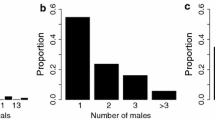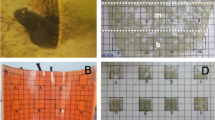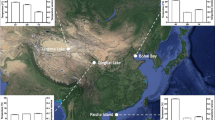Abstract
The distribution of breeding resources, such as nest sites, can have a pronounced impact on a population by affecting the proportion of individuals that succeed to breed and hence, the variation in reproductive success. Aggregation of important resources can lead to resource monopolisation by a limited number of individuals and thus affect the intensity of sexual selection. In this study, we tested, by contrasting two experimental treatments (dispersed vs. aggregated), how nest distribution affects: (1) mating behaviour, (2) male nest occupation and mating success, and (3) reproductive success and the opportunity for selection. We used the two-spotted goby (Gobiusculus flavescens), a small marine fish with a resource-based mating system, as our model species. When nests were aggregated, a larger proportion of the males behaved aggressively, fewer males succeeded in occupying a nest, fewer males became mated, and those males that mated received fewer eggs from spawning females. These effects resulted in a higher variance in reproductive success and hence, a higher opportunity for selection (I rs ), in the aggregated treatment. We suggest that the results are a direct consequence of males defending a territory around their nest, preventing competitively inferior males from breeding. However, we found no significant selection differentials for body length or condition of males in either treatment. Our results support the hypothesis that aggregation of essential resources like nests promotes resource monopolisation. In species facing highly clumped nesting resources in the wild, monopolisation may negatively impact population productivity but could lead to strong selection on traits that promote male competitive ability.





Similar content being viewed by others
References
Ahnesjö I, Kvarnemo C, Merilaita S (2001) Using potential reproductive rates to predict mating competition among individuals qualified to mate. Behav Ecol 12:397–401
Almada VC, Gonçalves EJ, Oliveira RF, Santos AJ (1995) Courting females: ecological constraints affect sex roles in a natural population of the blenniid fish Salaria pavo. Anim Behav 49:1125–1127
Amorim MCP, Neves ASM (2008) Male painted gobies (Pomatoschistus pictus) vocalise to defend territories. Behaviour 145:1065–1083
Amundsen T, Forsgren E (2001) Male mate choice selects for female coloration in a fish. P Natl Acad Sci USA 98:13155–13160
Amundsen T, Forsgren E (2003) Male preference for colourful females affected by male size in a marine fish. Behav Ecol Sociobiol 54:55–64
Andersson M (1994) Sexual selection. Princton University Press, Princeton
Arnold SJ (1983) Sexual selection: The interface of theory and empiricism. In: Bateson P (ed) Mate choice. Cambridge University Press, Cambridge, pp 67–107
Arnold SJ, Wade MJ (1984) On the measurement of natural and sexual selection: theory. Evolution 38:709–719
Banks SC, Lindenmayer DB, McBurney L, Blair D, Knight EJ, Blyton MD (2011) Kin selection in den sharing develops under limited availability of tree hollows for a forest marsupial. Proc R Soc Lond B 278:2768–2776
Bjelvenmark J, Forsgren E (2003) Effects of mate attraction and male–male competition om paternal care in goby. Behaviour 140:55–69
Borg ÅA, Forsgren E, Magnhagen C (2002) Plastic sex-roles in the common goby—the effect of nest availability. Oikos 98:105–115
Brevik C (2007) Reirplassvalg hos tangkutling Gobiusculus flavescens. Thesis (MSc), NTNU, Trondheim, Norway
Candolin U (1997) Predation risk affects courtship and attractiveness of competing threespine stickleback males. Behav Ecol Sociobiol 41:81–87
Collins SP (1981) Littoral and benthic investigations on the west-coast of Ireland—XIII. The biolgy of Gobiusculus flavescens (Fabricius) on the Connemara Coast. P Roy Ir Acad B 81:63–87
Darwin C (1871) The descent of man, and selection in relation to sex. Murray, London
de Jong K (2011) Operational sex ratio and reproductive behaviour in the two-spotted goby (Gobiusculus flavescens). PhD Thesis, NTNU, Trondheim, Norway
de Jong K, Wacker S, Amundsen T, Forsgren E (2009) Do operational sex ratio and density affect mating behaviour? An experiment on the two-spotted goby. Anim Behav 78:1229–1238
Emlen ST, Oring LW (1977) Ecology, sexual selection, and the evolution of mating systems. Science 197:215–233
Eriksen JM (2007) Parental care behaviour and costs in male two-spotted gobies (Gobiusculus flavescens). Thesis (MSc), NTNU, Trondheim, Norway
Forero MG, Tella JL, Donazar JA (1996) Can interspecific competition and nest site availability explain the decrease of lesser kestrel Falco naumanni populations? Biol Conserv 78:289–293
Forsgren E, Kvarnemo C, Lindström K (1996) Mode of sexual selection determined by resource abundance in two sand goby populations. Evolution 50:646–654
Forsgren E, Amundsen T, Borg ÅA, Bjelvenmark J (2004) Unusally dynamic sex roles in a fish. Nature 429:551–554
Fosså JH (1991) The ecology of the 2-spot goby (Gobiusculus flavescens Fabricius)—potential for cod enhancement. ICES Mar Sci Symp 192:147–155
Genner MJ, Turner GF, Hawkins SJ (1999) Resource control by territorial male cichlid fish in Lake Malawi. J Anim Ecol 68:522–529
Giske J, Aksnes DL, Lie U, Wakili SM, Lockwood SJ (1991) Computer-simulation of pelagic production in Masfjorden, Western Norway, and its consequences for production of released 0-group cod. ICES Mar Sci Symp 192:161–175
Grant JWA (1993) Whether or not to defend: the influence of resource distribution. Mar Behav Physiol 23:137–153
Grant JWA (1997) Territoriality. In: Godin JGJ (ed) Behavioural ecology of teleost fish. Oxford University Press, New York, pp 81–98
Griffiths SP (2002) Retention of visible implant tags in small rockpool fishes. Mar Ecol Prog Ser 236:307–309
Hop H, Gjøsæter J, Danielssen DS (1992) Seasonal feeding ecology of cod (Gadus morhua L.) on the Norwegian Skagerrak coast. ICES J Mar Sci 49:453–461
Hop H, Danielssen DS, Gjøsæter J (1993) Winter feeding ecology of cod (Gadus morhua) in a fjord of southern Norway. J Fish Biol 43:1–18
Huntingford FA, Turner AK (1987) Animal conflict. Chapman and Hall, London
Itzkowitz M (1974) The effects of other fish on the reproductive behaviour of the male variegated pupfish, Cyprinodon variegatus (Pisces:Cyprinodontidae). Behaviour 48:1–22
Itzkowitz M (1979) Territorial tactics and habitat quality. Am Nat 114:585–590
Jacot A, Valcu M, van Oers K (2009) Experimental nest site limitation affects reproductive strategies and parental investment in a hole-nesting passerine. Anim Behav 77:1075–1083
Johnsen S (1945) Studies on variation in fish in northern European waters. Bergens Mus Årb Nat Rekke 4:30–49
Jones AG, Walker D, Lindström K, Kvarnemo C, Avise JC (2001a) Surprising similarity of sneaking rates and genetic mating patterns in two populations of sand goby experiencing disparate sexual selection regimes. Mol Ecol 10:461–469
Jones AG, Walker D, Kvarnemo C, Lindström K, Avise JC (2001b) How cuckholdry can decrease the opportunity for sexual selection: data and theory from a genetic parentage analysis of the sand goby Pomatoschistus minutus. P Natl Acad Sci USA 98:9151–9156
Klug H, Heuschele J, Jennisons MD, Kokko H (2010a) The mismeasurement of sexual selection. J Evol Biol 23:447–462
Klug H, Lindström K, Kokko H (2010b) Who to include in measures of sexual selection is no trivial matter. Ecol Lett 19:1094–1102
Kodric-Brown A (1983) Determinants of male reproductive success in a pupfish (Cyprinodon pecosensis). Anim Behav 31:28–137
Koenig WD, Albano SS (1986) On the measurement of sexual selection. Am Nat 127:403–409
Kokko H, Rankin DJ (2006) Lonely hearts or sex in the city? Density-dependent effects in mating systems. Philos T Roy Soc B 361:319–334
Kvarnemo C, Ahnesjö I (1996) The dynamics of operational sex ratio and competition for mates. Trends Ecol Evol 11:404–408
Lehtonen T, Lindström K (2004) Changes in sexual selection resulting from novel habitat use in the sand goby. Oikos 104:327–335
Lindström K (1988) Male–male competition for nest sites in the sand goby, Pomatoschistus minutus. Oikos 53:67–73
Lindström K (2001) Effects of resource distribution on sexual selection and the cost of reproduction in sand gobies. Am Nat 158:64–74
Magnhagen C (1992) alternative reproductive behaviour in the common goby, Pomatoschistus microps: an ontogenetic gradient? Anim Behav 44:182–184
Magnhagen C (1994) Sneak or challenge: alternative spawning tactics in non-territorial male common gobies. Anim Behav 47:1212–1215
Magnhagen C (2006) Information about an opponent can decrease aggression in male common gobies competing for nest sites. Anim Behav 71:879–884
Magnhagen C, Kvarnemo C (1989) Big is better—the importance of size for reproductive success in male Pomatoschistus minutus (Pallas) (Piseces, Gobiidae). J Fish Biol 35:755–763
Malone JC, Forrester GE, Steele MA (1999) effect of subcutaneous microtagsbon the growth, survival, and vulnerability to predation of small reef fishes. J Exp Mar Biol Ecol 237:243–253
Mobley KB, Amundsen T, Forsgren E, Svensson PA, Jones AG (2009) Multiple mating and a low incidence of cuckoldry for nest-holding males in the two-spotted goby, Gobiusculus flavescens. BMC Evol Biol 9:6
Myhre LC, de Jong K, Forsgren E, Amundsen A (2012) Sex roles and mutual mate choice matters during mate sampling. Am Nat 179:741–755
Nellbring S (1986) A quantitative and experimental study of goby (Pomatoschistus spp.) nests on shallow soft bottom, Northern Baltic Proper. Ophelia 25:15–23
Nellbring S (1993) Spawning of two Pomatoschistus species (Gobiidae) in realtion to nest availability and depth: a field experiment. Neth J Sea Res 31:173–179
Pélabon C, Borg ÅA, Bjelvenmark J, Forsgren E (2003) Do male two-spotted gobies prefer larger fecund females? Behav Ecol 14:787–792
Reichard M, Juraida P, Smith C (2004) Male–male interference competition decreases spawning rate in the European bitterling (Rhodeus sericeus). Behav Ecol Sociobiol 56:34–41
Reichard M, Ondračková M, Bryjová A, Smith C, Bryja J (2009) Breeding resource distribution affects selection gradients on male phenotypic traits: experimental study on lifetime reproductive success in the bitterling fish (Rhodeus amarus). Evolution 63:377–390
Reynolds JD (1996) Animal breeding systems. Trends Ecol Evol 11:68–72
Santangelo N, Itzkowitz M, Richter M, Haley MP (2002) Resource attractiveness of the male beaugregory damselfish and his decision to court or defend. Behav Ecol 13:676–681
Saraiva JL, Barata EN, Canario AVM, Oliveira RF (2009) The effect of nest aggregation on the reproductive behaviour of the peacock blenny Salaria pavo. J Fish Biol 74:754–762
Searcy WA, Yasukawa K (1983) Sexual selection and red-winged black-birds. Am Sci 71:166–174
Shuster SM, Wade MJ (2003) Mating systems and strategies. Princton University Press, Princton
Singer A, Kvarnemo C, Lindström K, Svensson O (2006) Genetic mating patterns studied in pools with manipulated nest site availability in two populations of Pomatoschistus minutus. J Evol Biol 19:1641–1650
Skolbekken R, Utne-Palm AC (2001) Parental investment of male two-spotted goby, Gobiusculs flavescens (Fabricus). J Exp Mar Biol Ecol 261:137–157
Smith C (2011) Good fences make good neighbours: the role of landmarks in territory partitioning in the rose bitterling (Rhodeus ocellatus). Behaviour 148:233–246
Smith C, Reichard M, Douglas A, Jurajda P (2006) Population consequences of behaviour in the European bitterling (Rhodeus sericeus Cyprinidae). Ecol Freshw Fish 15:139–145
Spence R, Smith C (2005) Male territoriality mediates density and sex ratio effects on oviposition in the zebrafish, Danio rerio. Anim Behav 69:1317–1323
Strubbe D, Matthysen E (2009) Experimental evidence for nest-site competition between invasive ring-necked parakeets (Psittacula krameri) and native nuthatches (Sitta europaea). Biol Conserv 8:1588–1594
Sutherland WJ (1985) Chance can produce a sex difference in variance in mating success and account for Bateman's data. Anim Behav 33:1349–1352
Sutherland WJ (1987) Random and deterministic components of variance in mating success. In: Bradbury JW, Andersson MB (eds) Sexual selection: Testing the alternatives. Wiley, Chichester, pp 209–219
Svensson PA, Pélabon C, Blount JD, Surai PF, Amundsen T (2006) Does female nuptial coloration reflect egg carotenoids and clutch quality in the two-spotted goby (Gobiusculus flavescens, Gobiidae)? Funct Ecol 20:689–698
Wacker S, de Jong K, Forsgren E, Amundsen T (2012) Large males fight and court more across a range of social environments: an experiment on the two-spotted goby Gobiusculus flavescens. J Fish Biol 81:21–34
Wade MJ (1979) Sexual selection and variance in reproductive success. Am Nat 114:742–747
Westneat DF (2006) No evidence of current sexual selection on sexually dimorphic traits in a bird with high variance in mating success. Am Nat 167:171–189
Whiteman EA, Côté I (2004) Dominance hierarchies in group-living cleaning gobies: causes and foraging consequences. Anim Behav 67:239–247
Acknowledgments
We are grateful to Erlend Grandbo Rolseth for assisting with the experiment and to Katja Heubel, Carin Magnhagen, Ralph Dobler, Ola Svensson, Marcela Gonzalez, Lori Englebert, Dennis Sprenger, the Journal Club of the Animal Evolutionary Ecology at Tübingen University, Joachim Frommen, Franziska Schädelin and one anonymous reviewer for constructive comments on the manuscript. We thank the Sven Lovén Centre of Marine Sciences at Kristineberg for use of their facilities, technical support and hospitality. The study was financially supported by the Royal Swedish Academy of Science and the EU ASSEMBLE mobility programme.
Ethical standards
The study was conducted in accordance with Swedish laws on animal research and under license from The Swedish Board for Research on Animals.
Author information
Authors and Affiliations
Corresponding author
Additional information
Communicated by J. Frommen
Rights and permissions
About this article
Cite this article
Mück, I., Wacker, S., Myhre, L.C. et al. Nest distribution affects behaviour and mating success in a marine fish. Behav Ecol Sociobiol 67, 609–619 (2013). https://doi.org/10.1007/s00265-013-1480-2
Received:
Revised:
Accepted:
Published:
Issue Date:
DOI: https://doi.org/10.1007/s00265-013-1480-2




